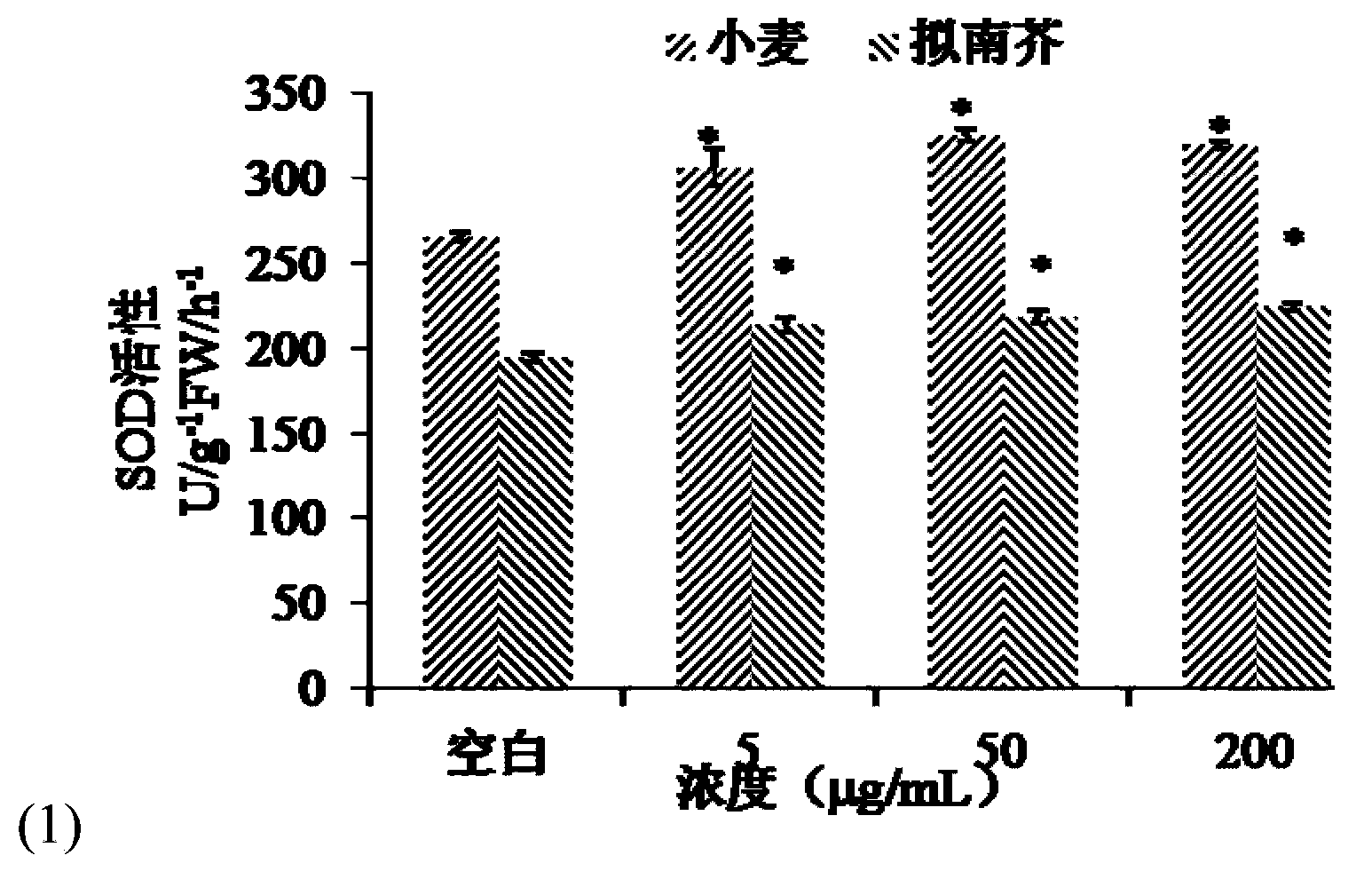Antioxidant and application thereof
An antioxidant, chlorella technology, applied in the field of glycobiology, to prevent enzymatic oxidative browning of food, a wide range of sources, and enhance the effect of anti-oxidation
- Summary
- Abstract
- Description
- Claims
- Application Information
AI Technical Summary
Problems solved by technology
Method used
Image
Examples
Embodiment 1
[0026] Embodiment 1 plant cell antioxidant experiment one
[0027] (1) Plant seed soaking experiment: using wheat Xinong "9871" for antioxidant experiment:
[0028] a) Wrap the wheat seeds with plump seeds and uniform size in gauze respectively, and wash them with running water for 10 minutes to remove impurities on the surface of the seeds and substances that prevent germination.
[0029] b) Soak the seeds in ethanol with a mass concentration of 75% for 5 minutes to remove protein and lipids on the surface of the seeds, and at the same time disinfect the surface of the seeds to prevent mold contamination.
[0030] c) at 5, 50, 200 μg·mL -1 The chlorella algae residue polysaccharide solution and deionized water were used to soak the sterilized seeds respectively, and soaked for 10 hours at room temperature.
[0031] d) Put the swollen seeds after immersion into a petri dish with 2 layers of filter paper on the bottom for culture, put about 30 seeds in each petri dish, do thr...
Embodiment 2
[0034] Embodiment 2 plant cell antioxidant experiment two
[0035] (1) Plant spraying culture: using Arabidopsis thaliana for antioxidant experiments:
[0036] a) Arabidopsis thaliana seeds were taken out from the refrigerator at 4°C and put into a 2ml centrifuge tube and added with sterile water;
[0037] b) Then planted in the soil, covered with plastic wrap and placed in an incubator (light-to-dark ratio 12 / 12, temperature 22±2°C).
[0038] c) About 4 days germinate and uncover the film, 21 days or so can grow 2 true leaves (related to the light time), spray 3 times on 31, 33, 35 days, the concentration is 0, 5, 50, 200μg·mL -1 Test polysaccharides, take samples and conduct experiments on the 38th day.
[0039] (2) Preparation of antioxidant enzymes in Arabidopsis cells: refer to "Preparation of antioxidant enzymes in wheat cells".
[0040] (3) Determination of enzyme activity: the same operation as described in "Plant Cell Antioxidation Experiment 1".
[0041] (4) Result...
Embodiment 3
[0043] Embodiment 3 in vitro antioxidant experiment
[0044] (1) Determination of reducing power: take a certain concentration of chlorella algal residue polysaccharide solution 1mL and 1mL0.2mol L -1 Phosphate buffer solution of pH 6.6 was mixed evenly, then 1 mL of 0.1% potassium ferricyanide was added, and the solution was bathed in water at 50°C for 20 min. After the reaction was completed, it was rapidly cooled, and the reaction was terminated with 1ml of 10% TCA. Take 2ml of this reaction solution, add 2ml of distilled water and 0.8ml of 0.1% FeCl 3 Mix well, and measure the absorbance value A of the mixture at 700 nm after 10 min. Use 1ml of distilled water instead of the sample as a blank control, and use 90μg·mL -1 Vc was used as a positive control. Three parallel samples were made for each sample, and the average value was taken. A 700 The larger the value, the stronger the reducing power of the sample. Measurement results such as figure 2 Shown: figure 2 ...
PUM
 Login to View More
Login to View More Abstract
Description
Claims
Application Information
 Login to View More
Login to View More - R&D
- Intellectual Property
- Life Sciences
- Materials
- Tech Scout
- Unparalleled Data Quality
- Higher Quality Content
- 60% Fewer Hallucinations
Browse by: Latest US Patents, China's latest patents, Technical Efficacy Thesaurus, Application Domain, Technology Topic, Popular Technical Reports.
© 2025 PatSnap. All rights reserved.Legal|Privacy policy|Modern Slavery Act Transparency Statement|Sitemap|About US| Contact US: help@patsnap.com



